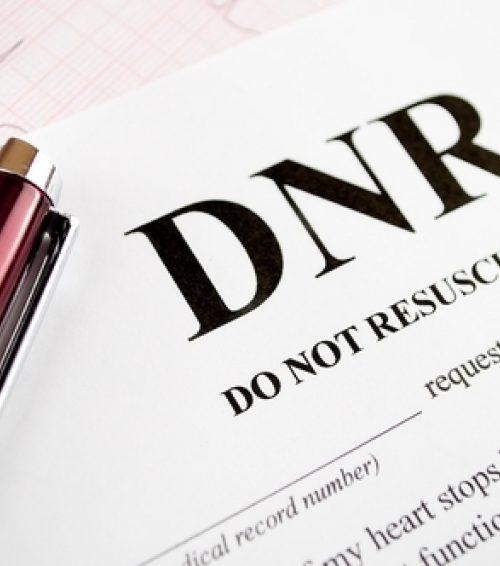 We all strive to do right by our patients, including abiding by their wishes surrounding resuscitation during surgery. I’m guilty of visibly cringing when I see the dreaded Do-Not-Resuscitate (DNR) sticker on the front of the chart. “This is a bad sign,” crosses my mind. In the brief amount of time you have to meet and examine the patient, formulate an anesthetic plan, properly consent the patient, and answer his and his family’s questions, adding a discussion about their DNR wishes seriously cuts into any down time between cases.
We all strive to do right by our patients, including abiding by their wishes surrounding resuscitation during surgery. I’m guilty of visibly cringing when I see the dreaded Do-Not-Resuscitate (DNR) sticker on the front of the chart. “This is a bad sign,” crosses my mind. In the brief amount of time you have to meet and examine the patient, formulate an anesthetic plan, properly consent the patient, and answer his and his family’s questions, adding a discussion about their DNR wishes seriously cuts into any down time between cases.
But postponing the coffee, tea or day-old donut break until you’ve had a real discussion about DNR during the perioperative period is an essential part of this patient’s care.
Do Not Resuscitate During Surgery
Up until the 1990’s, it was easy. DNR orders were automatically rescinded for a trip to the operating room. Typically, that’s no longer the case. Current recommendations involve a patient-physician dialog and plan, called a required reconsideration, rather than automatic cancellation of DNR orders in the perioperative period.
During orientation, it’s best to take time to review the healthcare facility’s DNR policies to know exactly where the organization stands. DNR policies are required for any hospital receiving Joint Commission accreditation. Based on the hospital’s policy, you’ll be able to have a frank discussion with the patient, surgeon, and primary care physician about the status of DNR orders during the perioperative period.
Do Not Resuscitate Guidelines Before, During, and After Surgery
The American Society of Anesthesiologists published an article with advice on the perioperative treatment of DNR orders, entitled “Ethical Guidelines for the Anesthesia Care of Patients with Do-Not-Resuscitate Orders or Other Directives That Limit Treatment.” It was most recently updated in 2018. Here are the most important points concerning canceling, amending, or maintaining perioperative DNR orders:
1) Communication between all parties (patient, the patient’s family members and/or healthcare proxy, anesthesia provider, surgeon, primary care physician) is paramount.
2) Anesthetics often require resuscitation in the form of airway management or treatment with vasoactive drugs. The anesthesia provider needs to tell the patient or his healthcare proxy what resuscitative procedures are part of the planned anesthetic. The final decision on DNR during surgery can take a few different forms:
- Armed with this knowledge, the patient may opt to cancel DNR orders prior to surgery, expecting full resuscitation.
- Alternatively, the patient may allow intubation, but not defibrillation or chest compressions, for example, limiting the resuscitation procedures you can perform. Document the procedures that are allowed and those that are not.
- A patient may ask you to use your clinical judgement, treating easily reversible complications but not treating complications from which he is unlikely to recover. This limitation in resuscitation is usually based on the patient’s wishes to forego long term “life support” after surgery. Again, you’ll need to explicitly document what is and is not allowed under different circumstances.
- The patient may wish to continue to be DNR, making peri-operative care extremely challenging.
3) The time frame for DNR orders to be reinstated also needs to be documented – whether it is upon awakening, after discharge from the recovery room, or once the patient has fully recovered from the surgery.
4) If you can’t abide by the patient’s wishes regarding resuscitation during surgery on moral grounds, then you’ll need to excuse yourself from the case and find a replacement.
If, on the other hand, the limitations imposed upon you would result in substandard care, the issue should be brought to the ethics committee. A patient refusing intubation for fixation of a C2 spinal fracture in the prone position would qualify, as it’s hard to imagine providing standard of care anesthesia under this circumstance.
5) The healthcare organization’s policy may dictate the plan – not you and the patient. If DNR orders are still being automatically rescinded for surgery, politely inform the patient and, of course, document the discussion.
The bottom line is this: Patients are autonomous, free to make decisions regarding their healthcare. As physicians, our goal is to first do no harm. Finding common ground requires a thorough discussion, mutual respect, and a willingness to compromise.
